The Apple Thunderbolt Display Review
by Anand Lal Shimpi on September 23, 2011 2:56 AM EST- Posted in
- Displays
- Mac
- Apple
- Thunderbolt
- Thunderbolt Display
Ever since I moved to a notebook as my main work computer I've become increasingly annoyed with the process of actually moving my notebook-as-a-desktop around. At my desk I've got DisplayPort, Ethernet, two USB, FireWire 800, speakers and power all plugged into a 15-inch MacBook Pro. What makes it frustrating isn't the first-world-problem of having to unplug seven cables, rather that it doesn't need to be seven cables - Apple could make the whole thing happen with just two.
Every Mac released in 2011 has at least one Thunderbolt port (the iMac has two), and Thunderbolt can deliver exactly what I'm looking for. Thunderbolt can carry two things: PCI Express and DisplayPort, the former for data and the latter obviously for video. Why would you want to carry PCIe and DP over a single cable? To address problems like the one above.
Pretty much all device expansion on modern day PCs happens via PCI Express. Several years ago it was hard to find PCIe sound cards or Ethernet controllers, but these days vanilla PCI slots are nearing extinction and PCIe is the de facto standard. Ethernet, USB and FireWire controllers all exist as single-lane PCIe devices. Put a bunch of them at the other end of a Thunderbolt cable and you no longer need to plug in a bunch of individual cables into your notebook when at your desk. Send DisplayPort over the same cable and you can actually move all of those ports onto your monitor, thereby using a single cable to carry everything but power to your display. And this is exactly what Apple has done with its new Thunderbolt Display. By mating its 27-inch LED Cinema Display with a bunch of integrated IO controllers, Apple is hoping to deliver a display that's more of a mobile docking station than just a passive way to display video.
Apple has tried this in the past. The old Cinema Displays used to feature an Apple Display Connector (ADC) that actually carried DVI, USB and power from a desktop Mac to the monitor. You only needed to plug in a single cable to your display, significantly reducing desktop clutter. Although Thunderbolt does carry power, it's limited to 10W - not enough to power any reasonably sized display. Where Thunderbolt does win out over ADC however is in its universal appeal. Intel created the standard. Although it's used almost exclusively on Apple systems today, come 2012 Intel is expecting PC OEMs to embrace the interface with its Cactus Ridge line of Thunderbolt controllers.

Apple's Thunderbolt Display
The Thunderbolt Display uses a near, if not perfectly, identical panel to what was in last year's 27-inch LED Cinema Display. You get a 27-inch, 16:9, 2560 x 1440 LED backlit display capable of at least 350 nits at full brightness. Apple seems to conservatively spec its desktop displays as we were able to measure 425 nits at max brightness. The uber brightness comes in handy because the display does have a glossy finish. Indoors it's not really a problem unless you're watching a dark movie scene with the display lit by a sun-facing window. Even then, cranking up the brightness all the way is usually enough to overcome any significant glare. As with all glossy displays, if you have light control (e.g. curtains or blinds) you'll be just fine.
The similarities don't end with the internal panel, the chassis is very similar to its older sibling and the Thunderbolt Display retails for the same $999 price.
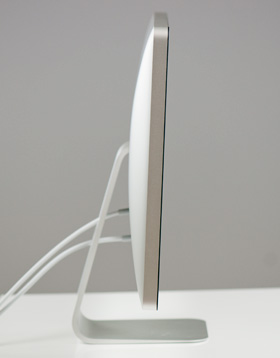 |
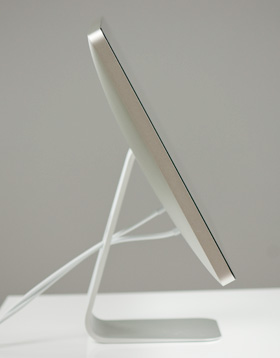 |
The display sits on an aluminum swivel base that allows for -5 degrees to 25 degrees of tilt along the horizontal axis. There's no height adjustment for the display either, only tilt. Personally, I use a height adjustable desk as I find it helps me avoid any carpal tunnel pain. Combined with a height adjustable chair, the lack of height adjustment on the display doesn't bother me. If you have a fixed height desk however, this may be a problem.
Aesthetically the Thunderbolt Display continues Apple's aluminum meets glass design language. The front of the display is all glass, while the edges and back are all aluminum. Along the top surface of the display is a mic for the integrated FaceTime HD camera. The outgoing 27-inch LED Cinema Display (still available for purchase online) sported a 640 x 480 camera, while the Thunderbolt Display ups capture resolution to 1280 x 720.
There's an ambient light sensor hidden in the top bezel of the display, but as always you can disable its functionality from within OS X.

There are two integrated speakers in the display, again unchanged from the previous LED Cinema Display.
Two cables attach directly to the display: a removable power cable and an integrated IO cable. Cable management is done through a round cutout in the aluminum stand. The IO cable is where things really change with the Thunderbolt Display. Instead of a breakout of three cables as was the case with the Cinema Display, there are now only two: MagSafe and Thunderbolt.
The MagSafe connector remains unchanged. If you've got any Mac that can be charged by an 85W MagSafe adapter, the Thunderbolt Display will charge said Mac. This feature alone is particularly awesome for notebook-as-a-desktop users since it allows you to just keep your actual AC adapter tucked away in your travel bag. For me I keep my MagSafe adapter in my bag and never take it out so I never have to worry about forgetting to pack it. Given how expensive MagSafe adapters are ($79 for an 85W), this is a nice feature for MacBook Air/Pro owners.
The Thunderbolt cable is obviously what gives this new display its name. Inside the Thunderbolt Display is an Intel Light Ridge Thunderbolt controller. The type of controller is important as it bestows upon the display some clear limitations. The biggest of course is the lack of support for all non-Thunderbolt systems. That's right, the only way to get video to the Thunderbolt Display is by using a Thunderbolt enabled Mac (or theoretically a Thunderbolt enabled PC). For Mac users that means only 2011 MacBook Pro, Air, iMac or Mac mini models will work with the Thunderbolt Display. Everyone else has to either buy a new Mac or stick with older displays.
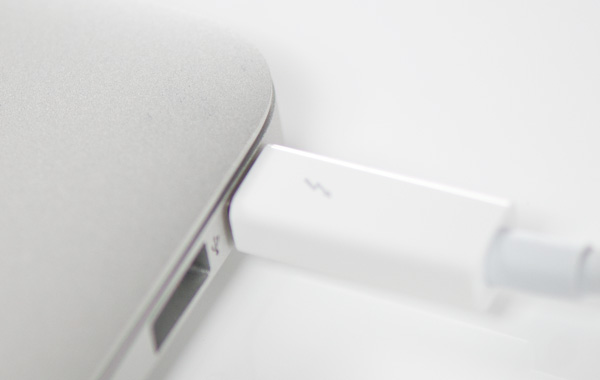
I believe the limitation here is actually on the cable side. A Thunderbolt cable can only transmit a Thunderbolt signal. Although DisplayPort is muxed in, if the display on the other end is expecting Thunderbolt and it receives DisplayPort it won't know what to do with it. It's possible Apple could have built in logic to autosense and switch between Thunderbolt and DisplayPort as inputs, but Apple traditionally employs clean breaks rather than long technology transitions. If Apple wants to ensure Thunderbolt gets adopted (at least by its users), this is the way to do it. As we learned from other legacy interfaces (e.g. PS/2, IDE), if you enable backwards compatibility you'll ensure the survival of systems that implement those interfaces. It's not so great for existing customers unfortunately.


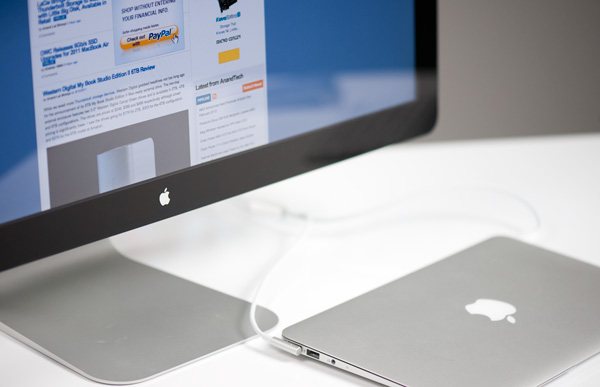
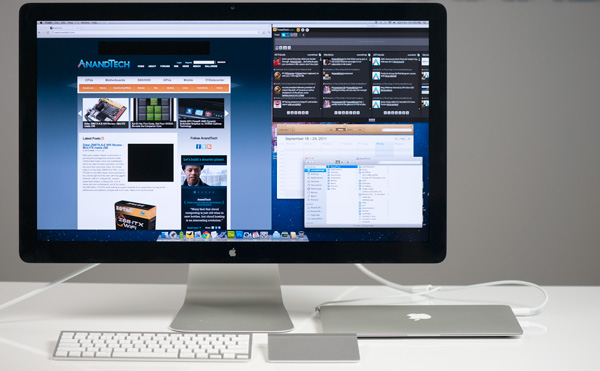
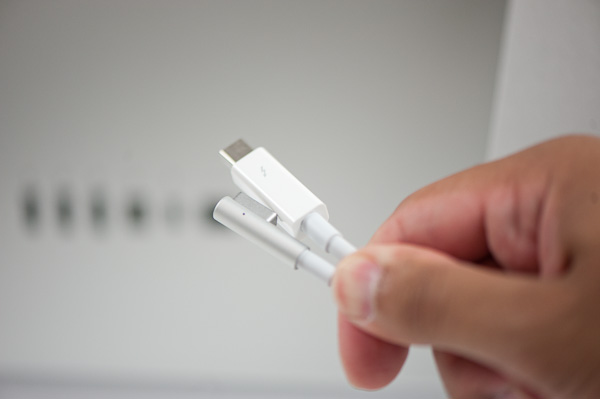








275 Comments
View All Comments
CharonPDX - Friday, September 23, 2011 - link
I had HOPED to buy either a Mac Mini or a MacBook Air this year. Finances aren't allowing that.But, it looks like sometime mid next year, I should be able to upgrade.
At this point, if Anand's wish comes true:
I'll be getting an 11" Ivy Bridge Air and a Thunderbolt Display.
Death666Angel - Friday, September 23, 2011 - link
"capable of at least 350 nits at full brightness"Just wanted to say that Apple actually advertises 375 cd/m² on their website. :-)
tzhu07 - Friday, September 23, 2011 - link
I wish Anand would've addressed the issue of the glossy-only screen option in the video review. Why did Apple and some others continue to seemingly promote this type of screen? There are many people that consider it a deal-breaker, including myself. How much of a hassle is it for Apple to have two variations of the same product?repoman27 - Friday, September 23, 2011 - link
"While the display does feature a pair of integrated speakers, they don't produce the best sound in the world. Thanks to their diminutive size and unusual enclosure, the speakers don't cover a lot of dynamic range and you can forget about any ultra low frequencies. If you like bass, you still need a sub."According to Apple's specs, the ATD has a 2.1 speaker system, so it already has a sub of sorts. Also the claimed power for the audio system is 49 watts, which is pretty staggering for something built into a display. Actually it's good compared to most compact PC desktop speaker systems. It's too bad that it impresses more on paper than it would seem to in real life.
dunce - Friday, September 23, 2011 - link
Can I use that Thunderbolt port on the back to plug in a second computer (MacMini/PC)? I am looking at this and the Dell 27in but would like multi computers inputs.Constructor - Saturday, September 24, 2011 - link
No, as far as I'm aware there can only be one master (CPU) on a Thunderbolt chain.kalistan919 - Friday, September 23, 2011 - link
Will Thunderbolt connections be available for the new 28nm gpus that are coming from AMD and Nvidia? Or will Ivy Bridge channel your discrete gpu from the gpu to motherboard to display through a thunderbolt connection on the motherboard? Does anyone know if Apple will come out with a 30" Thunderbolt Display like they did just recently with the 27" display?These are three questions I tried to find but couldn't. Here's another one...would a minidiplayport on the GPU card work with an apple thunderbolt monitor? Anyone have the lowdown on this? Thanks in advance.
ggathagan - Saturday, September 24, 2011 - link
The GPU's themselves do not dictate what type of connection is used; that's up to the video card manufacturer.Remember, however, that Thunderbolt is not a GPU-specific interface, so a discrete video card with a TB connection would require the manufacturer to add the TB controller and its associated circuitry to their video card.
I doubt that'll happen.
Ivy Bridge will not have integrated TB, so the answer to your 2nd question is also "no". The motherboard would have to take the video output, whether from the CPU or from a discrete GPU, and route it through an on-board TB controller.
30" displays are going away in most market sectors, so I doubt you'll see a 30" with Thunderbolt.
More specifically, I doubt you'll see *any* 30" display from Apple in the future.
As to your last question; from the article:
"A Thunderbolt cable can only transmit a Thunderbolt signal. Although DisplayPort is muxed in, if the display on the other end is expecting Thunderbolt and it receives DisplayPort it won't know what to do with it. It's possible Apple could have built in logic to autosense and switch between Thunderbolt and DisplayPort as inputs, but Apple traditionally employs clean breaks rather than long technology transitions. If Apple wants to ensure Thunderbolt gets adopted (at least by its users), this is the way to do it. "
According to this discussion at Apple's site, someone tried using a non-TB MBP and MBA and were not successful.
https://discussions.apple.com/thread/3199231?start...
What I would expect to see is someone marketing a Thunderbolt adaptor that converts a DP input to TB output.
In fact, I would expect to see Apple create this eventually, but it'll be atrociously expensive from them.
Since the whole point of TB is the ability to bundle multiple types of data traffic through a single interface, the only scenario where using a TB-equipped monitor currently make sense is one like this article describes; as an alternative to a docking station for a laptop.
It *would* make sense for a display manufacturer to make a TB-equipped monitor that could auto-sense with the input is DP or TB, but only if you're taking the same approach as Apple and include LAN, USB, audio and FireWire connectivity in the monitor.
If, for instance, Dell were to create a line of TB-equipped monitors with all the connectivity I described above, they could market those monitors in conjunction with a TB-equipped desktop and/or laptop series.
The desktops would only require the TB cable and a power cable; the monitor would handle all the peripheral connections.
Essentially, however, you end up having to decide if you want all your connections at the monitor or at the computer itself.
Historically, people prefer to limit the number of cables hanging off of their monitors and leave the rats nest at the computer.
Where I think TB hold the most promise in relation to desktop systems is in the area of external storage, like the Promise Pegasus Anand mentioned.
Impulses - Saturday, September 24, 2011 - link
Usually I skip video reviews entirely unless it's something that's just not communicable easily in text (factory tours and game trailer for instance)... They just tend to ramble on and/or provide very little info.However, the video on the first page of this review was excellent! You should've started doing these long ago, I actually read the entire review first even tho I'm not even remotely interested in the display (I am curious about Thinderbolt's future tho), and I started front to back as I often do (by reading the conclusion first and then skipping to other interesting parts). Having read the whole thing previous to watching the video I feel like the clip actually did a better job at summing it all up than the conclusion or Final Words, which is very impressive, great job!
ppayne - Saturday, September 24, 2011 - link
I'd love to see mods for this appear. Imagine 2 2.5 inch hard drives wired inside somehow and accessible through Thunderbold?